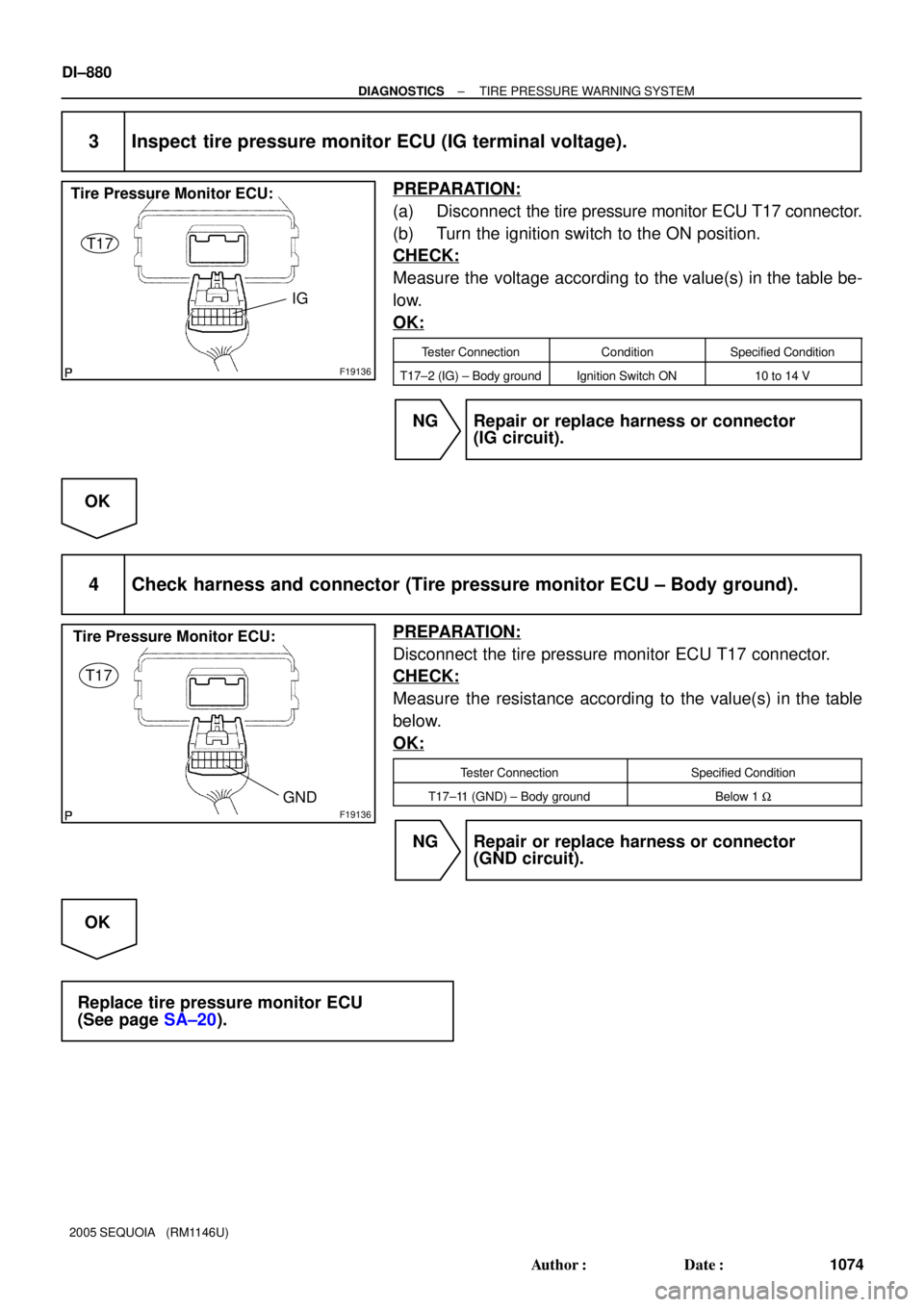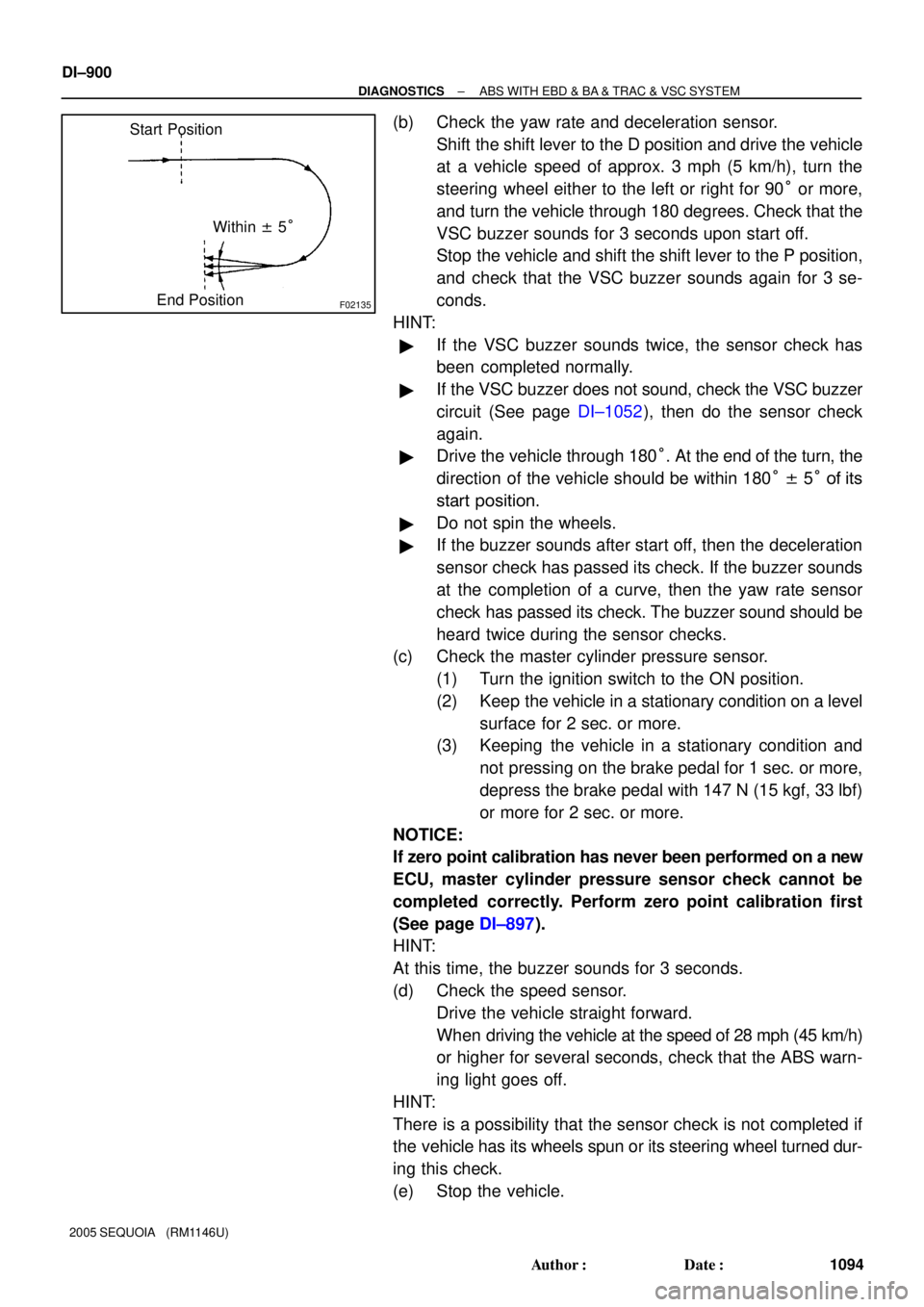Page 1082 of 4323

F19136
Tire Pressure Monitor ECU:
IG
T17
F19136
Tire Pressure Monitor ECU:
T17
GND
DI±880
± DIAGNOSTICSTIRE PRESSURE WARNING SYSTEM
1074 Author�: Date�:
2005 SEQUOIA (RM1146U)
3 Inspect tire pressure monitor ECU (IG terminal voltage).
PREPARATION:
(a) Disconnect the tire pressure monitor ECU T17 connector.
(b) Turn the ignition switch to the ON position.
CHECK:
Measure the voltage according to the value(s) in the table be-
low.
OK:
Tester ConnectionConditionSpecified Condition
T17±2 (IG) ± Body groundIgnition Switch ON10 to 14 V
NG Repair or replace harness or connector
(IG circuit).
OK
4 Check harness and connector (Tire pressure monitor ECU ± Body ground).
PREPARATION:
Disconnect the tire pressure monitor ECU T17 connector.
CHECK:
Measure the resistance according to the value(s) in the table
below.
OK:
Tester ConnectionSpecified Condition
T17±11 (GND) ± Body groundBelow 1 W
NG Repair or replace harness or connector
(GND circuit).
OK
Replace tire pressure monitor ECU
(See page SA±20).
Page 1091 of 4323
D13491
TC
D6DLC3:
F19136
T17
TC
Tire Pressure Monitor ECU:
D13491CGD6
DLC3:
± DIAGNOSTICSTIRE PRESSURE WARNING SYSTEM
DI±889
1083 Author�: Date�:
2005 SEQUOIA (RM1146U)
INSPECTION PROCEDURE
NOTICE:
It is necessary to register an ID code after replacing the tire pressure monitor valve sub±assy and/or
the tire pressure monitor ECU (see page DI±805).
1 Check harness and connector (DLC3 ± Tire pressure monitor ECU).
PREPARATION:
Disconnect the tire pressure monitor ECU T17 connector.
CHECK:
Measure the resistance according to the value(s) in the table
below.
OK:
Tester connectionConditionSpecified condition
D6±13 (TC) ±
T17±12 (TC)AlwaysBelow 1 W
NG Repair or replace harness or connector.
OK
2 Check harness and connector (DLC3 ± Body ground).
CHECK:
Measure the resistance according to the value(s) in the table
below.
OK:
Tester connectionConditionSpecified condition
D6±4 (CG) ±
Body groundAlwaysBelow 1 W
NG Repair or replace harness or connector.
OK
Page 1092 of 4323
F19136
T17
TC
Tire Pressure Monitor ECU:
DI±890
± DIAGNOSTICSTIRE PRESSURE WARNING SYSTEM
1084 Author�: Date�:
2005 SEQUOIA (RM1146U)
3 Check harness and connector (Tire pressure monitor ECU ± Body ground).
PREPARATION:
Disconnect the tire pressure monitor ECU T17 connector.
CHECK:
Measure the resistance according to the value(s) in the table
below.
OK:
Tester connectionConditionSpecified condition
T17±12 (TC) ±
Body groundAlways10 kW or higher
NG Repair or replace harness or connector and
each ECU.
OK
Replace tire pressure monitor ECU
(See page SA±20).
Page 1093 of 4323

DIDLU±01
± DIAGNOSTICSABS WITH EBD & BA & TRAC & VSC SYSTEM
DI±891
1085 Author�: Date�:
2005 SEQUOIA (RM1146U)
ABS WITH EBD & BA & TRAC & VSC SYSTEM
PRECAUTION
NOTICE:
When disconnecting the battery terminal, initialize the following system after the terminal is recon-
nected.
System NameSee Page
Back Door Power Window Control SystemBE±77
�When there is a malfunction in the contact point of the terminals or installation problems with
parts, removal and installation of the suspected problem parts may return the system to the
normal condition either completely or temporarily.
�In order to determine the malfunctioning area, be sure to check the conditions at the time the
malfunction occurred, such as by DTC output and freeze frame data output, and record it before
disconnecting each connector or removing and installing parts.
�Since the ABS with EBD & BA & TRAC & VSC systems may be influenced by a malfunction in
the other systems, be sure to check for DTCs in the other systems.
�Be sure to remove and install the ABS & VSC actuator and each sensor with the IG switch OFF
unless specified in the inspection procedure.
�When removing and installing the ABS & VSC actuator and each sensor, be sure to check that
the normal display is output in test mode inspection and in DTC output inspection after instal-
ling all the parts.
�After replacing the yaw rate sensor and/or the ABS & VSC actuator assembly, make sure to per-
form yaw rate and deceleration sensors' zero point calibration
(See page DI±897).
�The CAN communication system is used for data communication between the skid control ECU
(included in the actuator), the steering angle sensor, and the yaw rate sensor (the deceleration
sensor is included). If there is trouble in the CAN communication line, the DTC of the commu-
nication line is output.
�If the DTC of the CAN communication line is output, repair the malfunction and troubleshoot
the ABS with EBD & BA & TRAC & VSC systems.
�Since the CAN communication line has its own length and route, it can not be repaired tempo-
rarily with the bypass wire, etc.
Page 1097 of 4323
DI939±04
Vehicle Brought to Workshop
Customer Problem Analysis
P. DI±896
Check and Clear DTC
P. DI±911Items inside
are titles of pages in this manual,
with the page number in the bottom portion. See
the pages for detailed explanations.
Problem Symptom ConfirmationSymptom Simulation
P. IN±24
Symptom
does not occur
Symptom
occurs
DTC Check
P. DI±911
Sensor CheckCircuit Inspection
DTC Chart
P. DI±921Trouble codeProblem Symptoms Table
P. DI±905
Check for Fluid Leakage
P. DI±1059
Identification of Problem
Normal system code
Repair
Confirmation Test
End
1
2
3
4
5
67
89
10
11Step 2, 5, 8, 9, 11:
P. DI±925 ± DI±1057
Diagnostic steps permitting use of the
hand±held tester.
± DIAGNOSTICSABS WITH EBD & BA & TRAC & VSC SYSTEM
DI±895
1089 Author�: Date�:
2005 SEQUOIA (RM1146U)
HOW TO PROCEED WITH TROUBLESHOOTING
Troubleshoot in accordance with the following procedures:
Page 1099 of 4323

DIDLY±01
F09750
DLC3
Ts
Tc
CG
± DIAGNOSTICSABS WITH EBD & BA & TRAC & VSC SYSTEM
DI±897
1091 Author�: Date�:
2005 SEQUOIA (RM1146U)
CALIBRATION
1. ZERO POINT CALIBRATION OF MASTER CYLINDER
PRESSURE, YAW RATE AND DECELERATION SEN-
SORS
HINT:
When having replaced the master cylinder pressure, yaw rate
and deceleration sensors and/or the ECU, make sure to per-
form master cylinder pressure, yaw rate and deceleration sen-
sors' zero point calibration.
NOTICE:
�While obtaining the zero point, do not vibrate the ve-
hicle by tilting, moving or shaking it and keep it in a
stationary condition. (Do not start the engine.)
�Be sure to do this on a level surface (within an inclina-
tion of 1 degree).
(a) Perform master cylinder pressure, yaw rate and decelera-
tion sensors zero point calibration.
(1) Using SST, connect terminals Ts and CG of the
DLC3.
SST 09843±18040
(2) Shift the shift lever to the P position.
(3) Turn the ignition switch to the ON position.
(4) Keep the vehicle in a stationary condition on a level
surface for 4 sec. or more.
(5) Keep your foot off the brake pedal.
Do not leave 4WD vehicles in the L4 position.
(6) Press the center diff. lock (TRAC OFF) switch 3
times within 3 seconds.
(7) Check that the VSC buzzer sounds for 3 seconds.
HINT:
�If the VSC buzzer does not sound, do the zero point cal-
ibration again and/or check the VSC buzzer circuit (See
page DI±1052).
�If the VSC buzzer does not sound, check for yaw rate and
deceleration sensor failure (See page DI±911).
(8) Turn the ignition switch OFF.
(9) Disconnect terminals Ts and CG of the DLC3.
(b) Perform steering angle sensor zero point calibration.
This calibration is carried out automatically by following
procedures below:
(1) Make sure the system is not in sensor check mode.
(2) Calibrate the steering angle sensor by driving the
vehicle in a straight line at more than 7 MPH (12
km/h) for 5 seconds.
Page 1101 of 4323

DIDLZ±01
F09750
DLC3Ts
CG
BR3904
0.13 sec. 0.13 sec.
ON
OFF
± DIAGNOSTICSABS WITH EBD & BA & TRAC & VSC SYSTEM
DI±899
1093 Author�: Date�:
2005 SEQUOIA (RM1146U)
TEST MODE PROCEDURE
1. When not using the hand±held tester:
SENSOR CHECK (TEST MODE)
NOTICE:
When having replaced the master cylinder pressure, yaw
rate and deceleration sensors and/or the ECU, perform
zero point calibration of the master cylinder pressure, yaw
rate and deceleration sensors (See page DI±897).
HINT:
If the ignition switch is turned from the ON to the ACC or LOCK
position in test mode, test mode DTCs will be erased.
(a) Procedures for test mode:
(1) Turn the ignition switch OFF.
(2) Check that the shift lever is in the P position, and
turn the steering wheel to the neutral position.
(3) Using SST, connect terminals Ts and CG of the
DLC3.
SST 09843±18040
(4) Start the engine.
(5) Check that the ABS and VSC TRAC warning lights
blink.
HINT:
If the ABS and VSC TRAC warning lights do not blink, inspect
the ABS warning light circuit, VSC TRAC warning light circuit
and Ts terminal circuit.
(6) Keep the vehicle in a stationary condition on a level
surface for 4 sec. or more.
ABS warning light circuitDI±1021 or DI±1025
VSC TRAC warning light circuitDI±1027 or DI±1031
Ts terminal circuitDI±1057
Page 1102 of 4323

F02135
Start Position
End PositionWithin ± 5° DI±900
± DIAGNOSTICSABS WITH EBD & BA & TRAC & VSC SYSTEM
1094 Author�: Date�:
2005 SEQUOIA (RM1146U)
(b) Check the yaw rate and deceleration sensor.
Shift the shift lever to the D position and drive the vehicle
at a vehicle speed of approx. 3 mph (5 km/h), turn the
steering wheel either to the left or right for 90° or more,
and turn the vehicle through 180 degrees. Check that the
VSC buzzer sounds for 3 seconds upon start off.
Stop the vehicle and shift the shift lever to the P position,
and check that the VSC buzzer sounds again for 3 se-
conds.
HINT:
�If the VSC buzzer sounds twice, the sensor check has
been completed normally.
�If the VSC buzzer does not sound, check the VSC buzzer
circuit (See page DI±1052), then do the sensor check
again.
�Drive the vehicle through 180°. At the end of the turn, the
direction of the vehicle should be within 180° ± 5° of its
start position.
�Do not spin the wheels.
�If the buzzer sounds after start off, then the deceleration
sensor check has passed its check. If the buzzer sounds
at the completion of a curve, then the yaw rate sensor
check has passed its check. The buzzer sound should be
heard twice during the sensor checks.
(c) Check the master cylinder pressure sensor.
(1) Turn the ignition switch to the ON position.
(2) Keep the vehicle in a stationary condition on a level
surface for 2 sec. or more.
(3) Keeping the vehicle in a stationary condition and
not pressing on the brake pedal for 1 sec. or more,
depress the brake pedal with 147 N (15 kgf, 33 lbf)
or more for 2 sec. or more.
NOTICE:
If zero point calibration has never been performed on a new
ECU, master cylinder pressure sensor check cannot be
completed correctly. Perform zero point calibration first
(See page DI±897).
HINT:
At this time, the buzzer sounds for 3 seconds.
(d) Check the speed sensor.
Drive the vehicle straight forward.
When driving the vehicle at the speed of 28 mph (45 km/h)
or higher for several seconds, check that the ABS warn-
ing light goes off.
HINT:
There is a possibility that the sensor check is not completed if
the vehicle has its wheels spun or its steering wheel turned dur-
ing this check.
(e) Stop the vehicle.